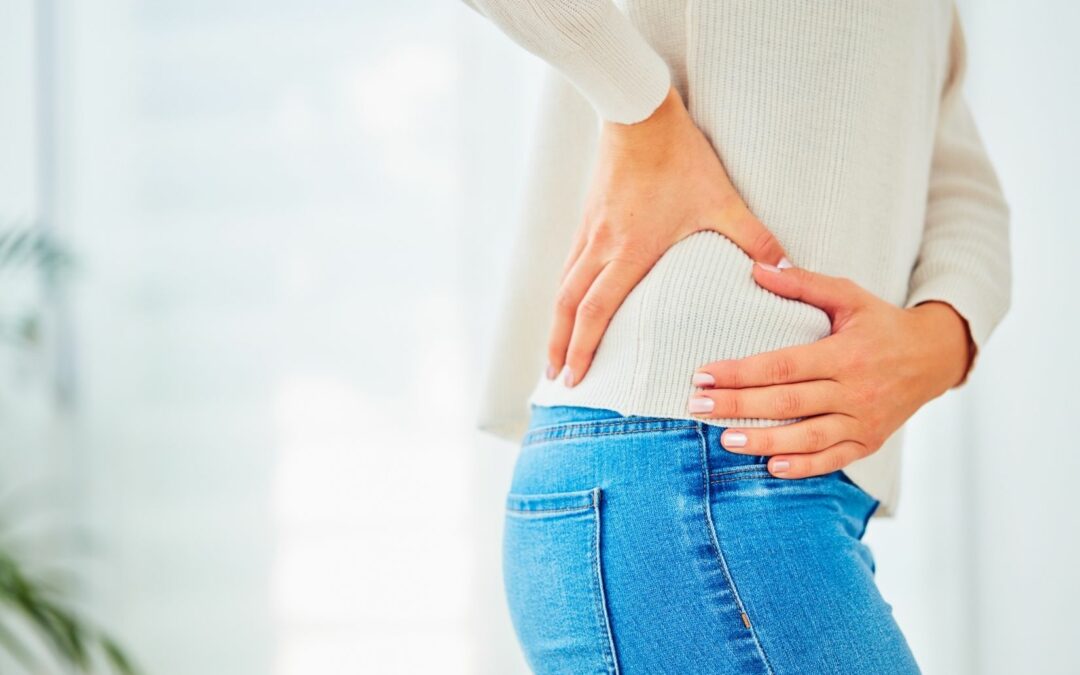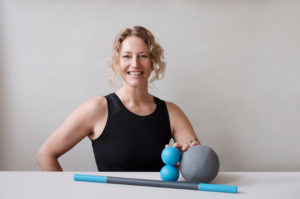Cat Matlock here at FreeBody. Let’s talk about hips. Does your hip give out? Does it feel like it is on the edge of giving out or sometimes it can’t hold your weight? I’m going to explain these symptoms to you and teach you how to fix it.
So let’s get started. Why does it sometimes feel like your hip is just going to give out or it can’t hold your body weight. I have seen this regularly enough in my massage practice over the last almost 30 years. To understand why it happens and how to really fix it, I want to first help you understand a little bit about the muscles that are weak in this scenario. Those muscles are the ones on the very side of your hip and this is gluteus minimus and gluteus medius. Most everyone is familiar with big old glute max, in the back of your butt. Then on the side of the hip, you have two mini versions of the medium and smaller glutes, medium and minimus, and what they do is lift your leg out to the side.
Now here’s the thing. Lifting the leg to the side, called hip abduction, is the more commonly known job of glute min and med. They’re lesser known job, and the title that I have given these muscles, is as the rotator cuff of the hip. When glute min and med contract together, they stabilize the femur in the socket, so when the foot doesn’t move, when the leg doesn’t move out to the side and these muscles contract, or when you’re standing, running, or walking and your foot hits the ground, these muscles contract to push that femur into the socket. So when they are weak and you put your foot down, you hip just wants to give out. It can feel like you can’t even stand with your weight on that leg. It might be accompanied by some symptoms like SI joint issues, maybe some restless legs or a deep ache in your buttocks, some groin tension on the same side, or opposite side.
Why does this happen? And why does it sometimes come on suddenly? In my experience, the reason is often postural. I also see many folks have issues with their hips when they do things where they’re hugging in with their legs, like cycling, riding motorcycles, riding horses, and so on.
Inner Thighs & Outer Hips
See, gluteus minimus and medius cover the side of the pelvis and then attach into the very top of the femur. These muscles have to counter the pull of the inner thigh muscles. Inner thigh muscles are called the ADductors. Gluteus minimus and gluteus medius on the outer hips are the ABductors. So inner thighs draw the legs towards each other, Gluteus minimus and gluteus medius draw the legs away from each other. So there’s this dynamic tensional play between these two groups of muscles and what can happen over time is that the inner thighs, depending on posture or activities, might become too much for the outer hips to resist or to balance. So we have to build strength in the outer hips. This will help, but it won’t take you all the way. You haven’t addressed perhaps the tension of the inner thighs, which is maybe where this is all beginning. So if the inner thigh muscles are tight and short, the outer hip muscles become tight and long.
If the inner thigh muscles are tight and short because of hugging in or posture, the outer hip muscles can get tight and long. Muscles don’t like to be pulled long. We almost always feel our pain, our tension, a pulling sensation in the muscle groups that are pulled too long, and they lose their mechanical advantage and their ability to do their jobs well.
To really address the hip weakness you’ll have to release the inner thighs. You have to address those adductor muscles first, then do your hip strengthening. You might want to clear some trigger points and do self trigger point release in your outer hips, then you can do your strengthening, then your muscle will reset, usually pretty quickly. Start with some foam rolling, some self trigger point release inner thighs, and then do some strengthening.
Posture
So let’s talk about posture. What kind of postures would get me into this problem? Well, the main posture that causes this is sitting with the legs crossed. I know, we all do it, especially if you’re a lady and you’ve been taught to This is also a posture of protection. I’m protecting by drawing everything in to center and kind of closing myself off. So the first thing to do is become mindful that you’re crossing your legs maybe all the time and to uncross them and sit with your feet about hip distance apart or so and let there be some space in between your knees. When we draw the knees together, even cross them over each other, what ends up happening is that the femurs come toward each other, shortening these adductors and pushing the femurs at the outer hips outward.
If you bring your knees toward each other, even crossing, you’re pushing the femurs out of the socket of the hip and this is where glute min and med come in. They read that pushing of the femur out of the socket as a message to contract and get that femur back into the socket. Except if the legs are habitually crossed, the muscles are being pulled long and the inner thighs made short. Over time that weakness in the muscle is going to cause the outer hip strengthening to be less effective than if you rolled the inner thighs and spend a little time opening up the inner thighs first.
Let’s recap. The hip gives out when there’s tension and weakness in the muscles that are the rotator cuff of the hip, gluteus minimus and medius. Gluteus minimus and medius live on the outside of the hip. Their job is to stabilize the femur in the socket with every step that you take. Certain activities like running, bike riding, or constant leg crossing, can pull the out hip muscles long, potentially weakening them.
I hope you have found this info helpful and it can direct you towards healing, strengthening, and feeling more ease in your body.




